Will citizens of big cities in China ever enjoy blue sky?
The People’s Republic of China (PRC) was perhaps one of the countries mentioned the highest number of times during the United Nations Climate Change Conference (COP21) in December 2015 in Paris. Indeed PRC as the biggest CO2 emitter can now be reasonably portrayed as the main player on energy demand and combat against the climate change. Quite symbolically (and ironically in a sense) though, two big waves of severe pollution struck the capital region of China both before the conference and right after it, resulting in “red alert” notification, issued by the officials. Needless to say, Beijing has been infamous for polluted air and smog for a long time, but the situation when the concentration of fine particulate matters (PM 2.5) exceeded 500 μg/m3 (whereas the maximum safe level is 25 μg/m3, according to the World Health Organization) or in some areas up to horrendous 1000 μg/m3 had been unheard of even for air quality monitoring stations in China.
While some citizens of those cities, already having got used to the air pollution far beyond the environmental standards, responded with a sense of humour or ironically, others, including delegates in Paris and environmentalists, wondered when this kind of weather conditions are coming to an end.
Having analyzed International Energy Agency (IEA) projections, as well as Chinese environmental and energy strategies, let us try to project when the horizon over major Chinese cities becomes clear and Chinese citizens could enjoy the weather which poses no threat to one’s health.
This article, however, might lack some holistic approach, as even though not denying the significance of the social level, it will primarily deal with scientific and legal measures to tackle the issue of air pollution (and climate change, as the two are closely related). Furthermore, even though heavy metal pollution remains a serious threat for some regions in China, this article will deal with airborne pollutants, as well as greenhouse gases, both of which are potentially hazardous not only on national, but on the global scale as well.
What obstructs people’s right to clean air?
When talking about air pollution in Chinese cities, one has to define a sector which is the most culpable for it. This is, however, not that easy to measure, as all sources are intertwined. For instance, even though Sohu business estimates that 22% of pollution comes from vehicle emissions, 17% from coal power plants, 16% from industrial emissions, 25% are attributed to the surrounding districts-induced pollution, a source ambiguous in itself, as it likely include coal and industrial emissions as well. These numbers are well-known for the Ministry of Environmental Protection of the People’s Republic of China (MEP) as well, so why the situation is seemingly not improving at all, as we saw from an outbreak of a terrible level of pollution last year?
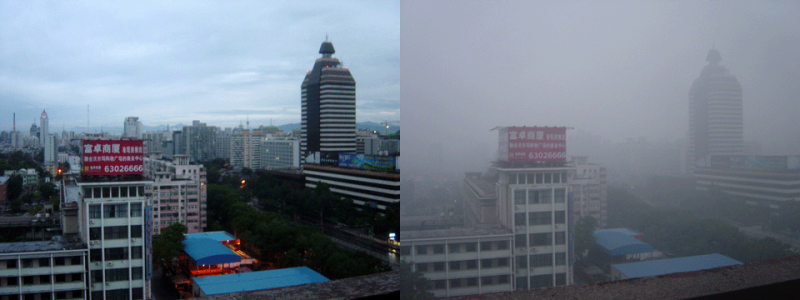
The visual difference between very low (left) and high (right) levels of pollution in Beijing.
One of the most significant culprits is coal-powered plants. Using coal as a means for energy generation is the dirtiest (both in terms of greenhouse gas (GHG), PM and gaseous pollutants emissions) and least effective type of plants. Nevertheless, since it is a relatively cheap fuel, it is still extensively used by developed countries, the United States and Japan in particular, for energy generation and for steel and iron industry by others. Nevertheless, PR China here easily overtakes any other country, as its consumption extends for over half of the world’s total coal consumption and is being built continuously due to an energy demand growth and its abundant coal resources. As long as its share in consumption remains dominant, there is hardly any basis to hope for clean air in the country. On the other hand, there are some signs for the improvements in energy policy and tendencies. The year 2014 saw a decline of emissions, linked to a decline of coal by 3%, even though the economic growth was quick enough, exceeding 7%. Of course such a small decline is partly cyclical, but the demand growth by other energy sources, such as wind and solar, as well as natural gas, suggests the dirtiest method being suppressed at least for a little while on a more sustained basis. This is the first coal consumption decline in 2 consecutive years in Chinese market since 1982 (IAE data). Therefore, it is a good start for a more sustainable economy, but is far from being sufficient as a recent wave of air pollution showed.
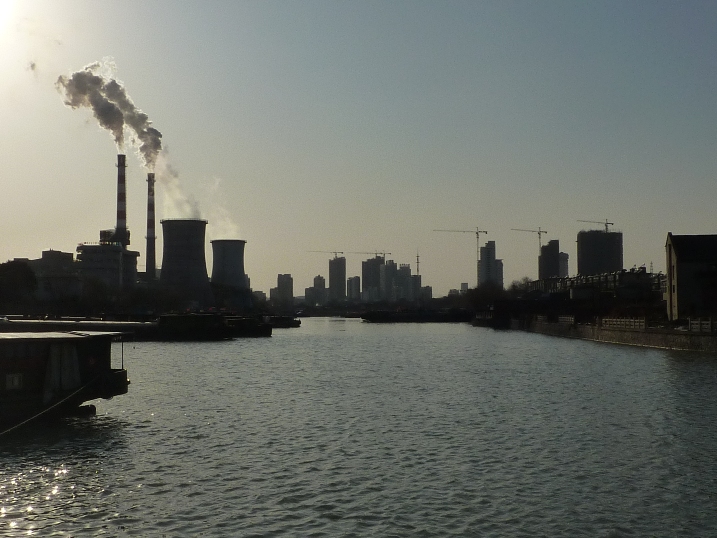
Yangzhou Power plant, one of numerous coal plants in China that constitute some two thirds of a national market share for power generation.
There is no doubt that coal-fired plants will still play an important role for the years to come, and especially up until the year 2030, when the CO2 emissions are projected to reach the peak in China. Even though the emissions are going to start decreasing in the subsequent years, the coal will still be playing the most significant role in Chinese energy sector. A total of 62% of total primary energy demand is planned to be covered by coal in 2020 (down from 66% in 2012).
Furthermore, coal-fired plants themselves vary in their efficiency. While Chinese government has set stricter criteria for the ones to be built, there are still some very inefficient ones continuing operating and polluting the air with impunity, as they are technically capable of continuing to operate. What is more, even more troubles are caused by small industrial and commercial coal-fired boilers which are complicated to monitor, despite the attempts to discourage coal-based boilers’ usage.
Will renewable energy save China?

Gansu Wind Farm in western Gansu province in China. When completed, it might become the world’s largest wind farm with a capacity of 7,965 MW.
Contrary to the public opinion that might arise from the image of a never-ending pollution in Beijing and China as a whole, the Chinese government has taken some decisive steps to make its economy less carbon intense and therefore decrease the levels of pollution in its biggest cities and nationwide. One of such moves is an increasing level of funds allocated for research and development of “alternative” energy sources and modernization of older plants. Recently China has emerged as the biggest investor and producer of renewable energy in the world. Investment for renewable energy sources (mainly wind, solar and hydropower) amounts for $54 billion per year, or 60% of the total energy capacity (IEA data, 2015). This means that over time renewable energy sources (solar, wind energy among others) are going to take an increasingly bigger share in the total energy sector, as the investment is planned to increase even further. Will that lead China into a cleaner future? It could, but the closure of the least energetically-efficient coal-fired plants has to follow. However, this move is not going to be easy, as most of them were built in 2000, so are not bound to be retired legally, not to mention their replacement with significantly more expensive low-carbon plants. Therefore, it is expected that PRC will introduce CO2 taxation by 2020, using a similar scheme as the European Union does. Such a measure would help initially expensive renewable energy sector to penetrate in the sector, dominated by fossil fuel.
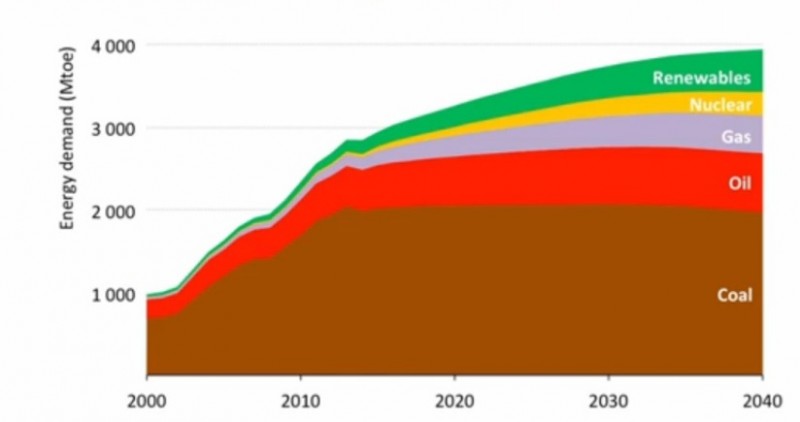
Projected energy demand in the PRC. Coal will remain the core source in country’s energy sector. (IEA graph)
According to the IEA calculations, the growth of the renewable sector in China will be led primarily by hydropower, wind and solar power plants (power generation capacity from wind increases by 220 GW by 2030 and from solar PV by 155 GW). Nevertheless, even with this scenario in place, renewable energy sources are going to play only around 20% of total primary energy demand by the year 2030 (compared to 10% in 2013). In comparison, renewable energy sector is projected to overtake coal as the main source in electricity generation globally around 2030.
Traffic and pollution
Another issue to be tackled is the pollution that comes from an intense traffic. Its influence on weather quality is undisputed, as seen at the time Olympic Games were hosted in Beijing in 2008. At that time, many factories were temporarily suspended and the number of cars on the road was limited by implementing alternate-day driving restrictions, depending on the last number on the license plates of vehicles. Despite temporary improvements that lasted throughout the Olympics and made weather significantly cleaner, the policy was discontinued and China again struggles with harnessing its dense traffic in the cities and enormous amounts of exhaust fumes resulting from it. In order for the transportation to be more environmentally feasible, the Chinese government released its emission standard, equivalent to Euro III standards in 2007. Furthermore, a year later a more advanced standard, Euro IV, was introduced to Beijing (in comparison, EU, South Korea and Japan use Euro VI, Russia uses Euro V, India uses a combination of III and IV standards) and it is thought for the standard to catch up with the one of South Korea by 2025. Due to more advanced technologies, CO2 emissions per square metre of residential floor space decline by nearly 30% in 2030 and the growth in transport GHG emissions slows down as well (IEA data, 2015).
Chinese efforts for a change
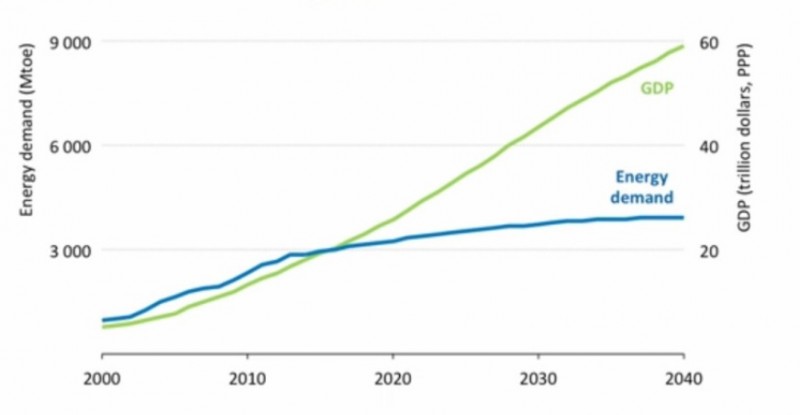
As energetic efficiency is expected to become increasingly higher, the relation between country’s GDP growth and energy demand decouples. (IEA graph)
As the weather quality in Chinese cities often poses a threat to the civilians (constant inhalation of particulate matters triggers cardiovascular and pulmonary disease and might cause cancer), the central government has been taking action to combat with both pollution and climate change. As a result, China became the first developing country to publish a national strategy regarding global warming in 2007. In 2012 it established goals to reduce carbon intensity and raise energy consumption intensity, particularly focusing on biggest industrial cities, with more demanding targets for them. In addition to that, emission trading scheme, similar to the one in Europe was attempted to be set up in Beijing, Shanghai and Tianjin in 2009, but was not successful.
Contrary to the expectations of some most pessimistic environmental analysts, the leaders of PRC and the United States, the 2 biggest CO2 emitters, signed a Joint Announcement on Climate Change and Clean Energy Cooperation in November 2014. The announcement obliged both countries to engage in technological cooperation in order to achieve “ambitious climate goals” and to reach their objectives of curbing CO2 emissions. This was a significant step, positively affecting global energy policy worldwide, as it was very unlikely for any party to make some more ambitious pledges alone, because of economic reasons.
China remained an important party in the COP21 negotiations with its head of state, Xi Jinping, present. As a result of the joint agreement between the 2 biggest economies, both China and US presented their Intended Nationally Determined Contributions (INDCs), paving the way for the 2 biggest pollutors to stand up for more sustainable energy policies. Besides, INDC strategy was evaluated as “medium with inadequate carbon intensity targets” by The Climate Action Tracker. This is a satisfactory evaluation, taken into account that both American and Chinese policies had been previously dubbed negligent and inadequate to combat climate change.
A few weeks after the conference and nightmarish smog, at the beginning of 2016, Beijing announced a “long-term plan to improve air quality to the clean level by around 2030”. This might be a stepping stone to ending seemingly endless air pollution which sweeps not only Beijing, but at times even the cities considered to be among the cleanest in the country. A more detailed plan of a long-term environmental protection is expected to be released by the end of the year by Chinese environmental agencies. If the goals succeed, by around 2030, the average concentration of PM 2.5 in Beijing is expected to decrease to 35 μg/m3, 2 times cleaner than it is considered by a national standard, but slightly above the World Health Organisation (WHO) recommendations (25 μg/m3). So based on this, we can expect the Pekinese to be able to finally enjoy clear sky in 2030s. However, such a goal is not that easily achievable as despite the decrease of PM 2.5 concentration by almost 12%, its annual measurement remains strikingly high – 80.6 μg/m3 (and with the national annual PM 2.5 air pollution equal to 54 μg/m3, PRC remained one of the most polluted countries in the world in 2013 (The World Bank Data, 2013). Nevertheless, the State Council stipulates for the number to decrease to 60 μg/m3 by 2017.
Even though critical levels of air pollution, accompanied with smog, will remain a painful issue for the Chinese Government, China was praised for being a leader in energetically efficient residential buildings (and 2nd in commercial buildings), as evaluated by American Council for an Energy-Efficient Economy in 2015.
Prospects for China free of pollution
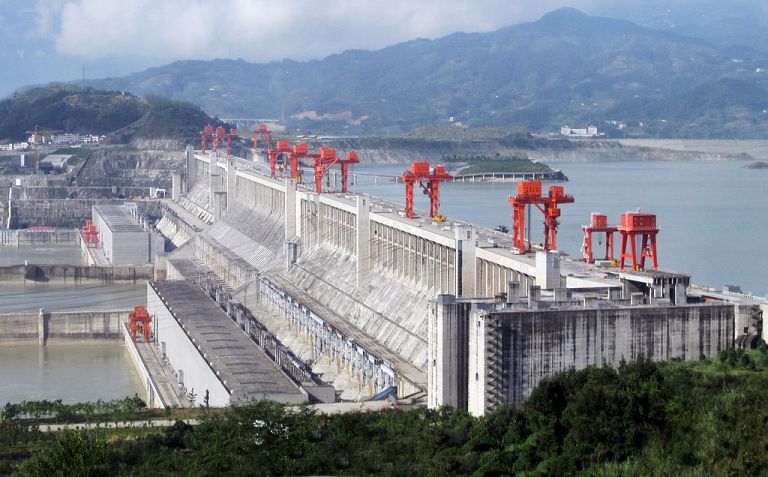
Three Gorges Dam, a hydroelectric dam in Hubei Province, China is the world’s largest power station in terms of installed capacity (22.5 GW). Its total energy generation outnumbers Lithuanian annual energy consumption. However, such enormous hydropower stations are not without drawbacks either.
Despite all the progress that has been and is pledged to be made by the Chinese government, pollution remains a serious issue all across the country, despite slightly lower level of pollutants on average over the past 3 years. Since pollution is not a local problem, but can be extended far from the primary source, it threatens not only China, but also its neighbours on several occasions. The air pollution is a major concern of both people and the government. Taken into the account the data from scholars, governmental and non-governmental analysts, the following proposals should be taken into account, so that the “doomsday” of smog could become a history and citizens would enjoy satisfactory quality of weather.
- To curb the usage of coal for burning, including small industrial boilers which are hard to monitor.
- To upgrade existing coal power plants into more efficient ones and to favour other sources for energy generation, particularly renewable ones.
- Since renewable energy sources are significantly less cost-efficient, introduce a carbon tax which would encourage the renewable energy sector to penetrate into the national energy sector more successfully.
- To improve public transportation, so that people will be more willing to prefer it over their own cars. To introduce more stringent fuel-economy standards in transport.
- To continue reforestation and include green areas and public parks when planning city infrastructure.
I hope the Central Chinese Government will take into account all points. Despite the air pollution level being one of the highest among world’s capitals, Beijing has shown self-determination to combat the level of pollutants. Therefore, if it finds enough political will to fulfill its pledges, air-pollution masks might have become a history by 2030 or even a bit earlier. That might require some patience, as good quality air is unlikely to prevail in the foreseeable future.
Author: Audrius Sabūnas
Additional information
Primary sources:
- International Energy Agency data (World Energy Outlook 2015, including Energy and Climate Change)
- The World Bank
- Climate Action Tracker
Secondary sources:
- Yardley, Jim. China Announces More Pollution Controls. The New Year Times, Aug. 1, 2008
- Berger, Michele. Pollution in China May Alter Weather in United States, Research Shows, Weather.Com, 4 Feb. 2015
- Jinran, Zheng, “Capital plans to beat smog by 2030”, China Daily Asia, 5 Jan. 2016
- Yuxia, Jiang. China issues national plan to address climate change. www.chinaview.cn. Jun. 4, 2007
- The White House. Office of the Press Secretary. U.S.-China Joint Announcement on Climate Change. Nov. 11, 2014.
- Bonnie, Malkin. Pollution from China grounds flights in Tibet. The Telegraph. Dec. 20, 2013.
- The International Energy Efficiency Scorecard, American Council for an Energy-Efficient Economy
- China smog: Beijing issues second ever pollution red alert. BBC. Dec. 18, 2015
- Lin, Luna. Airpocalypse now: China pollution reaching record levels. The Guardian. Nov. 9, 2015
- Holmes, Frank. China Plans To Add A Mind-Boggling 800 Miles To Its Subway System Over 2 Years. Business Insider. Mar. 19, 2013
Photos:
- Wikimedia Commons
- International Energy Agency
